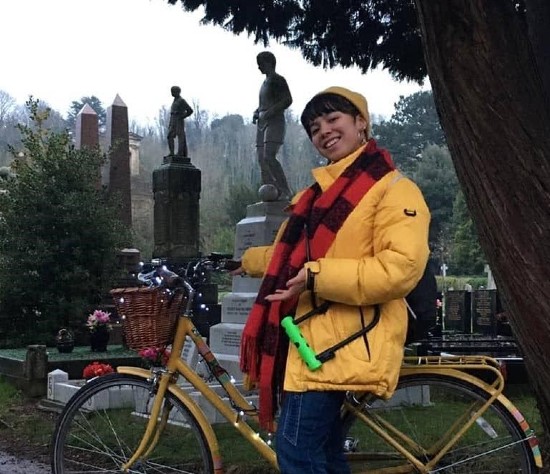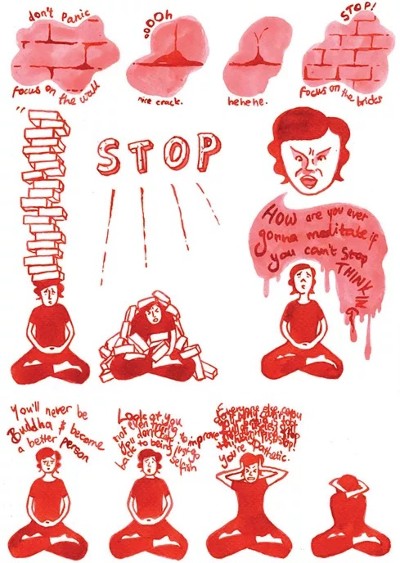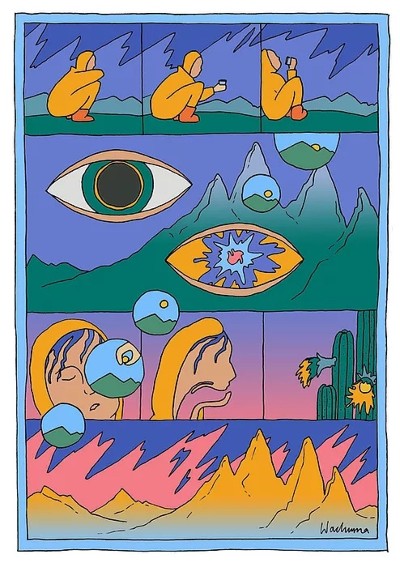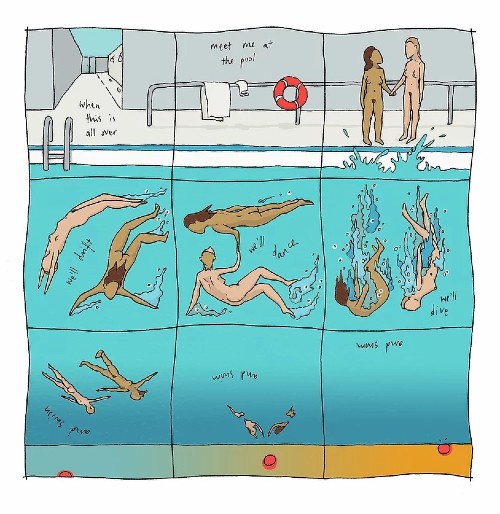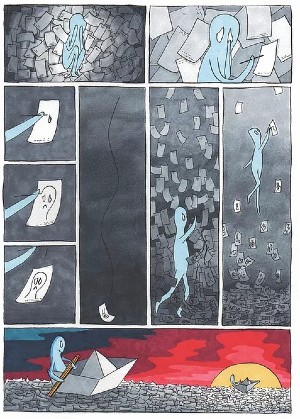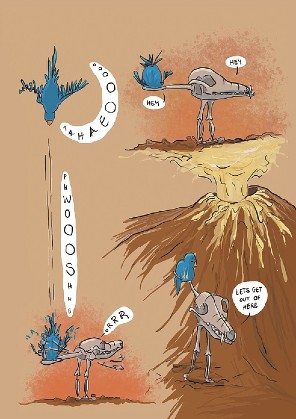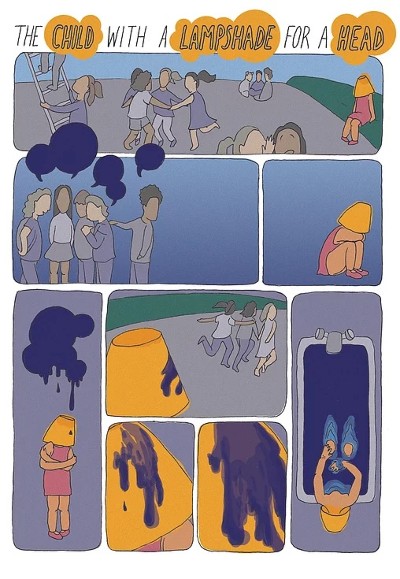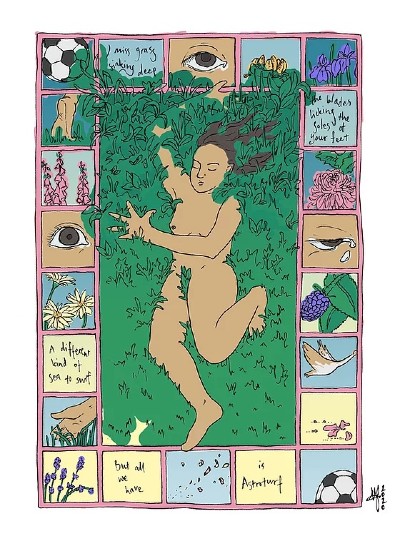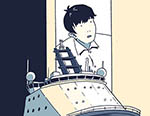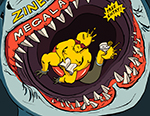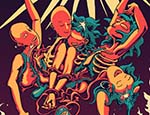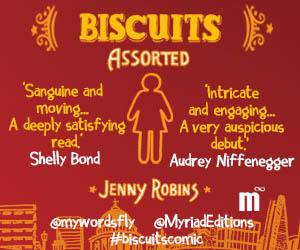Back when we announced this year’s Broken Frontier ‘Six Small Press Creators to Watch’ I spoke about today’s interviewee Mereida Fajardo in the following terms: “I always gravitate towards creators who constantly experiment with the form and see the comics page as a canvas to explore and exploit; artists whose work shows a desire to push and break through the boundaries of the medium, not to be confined by them. That’s very much something I see in the comics of Mereida Fajardo.”
Indeed earlier this year at BF I spoke of her experimental comics collection Quark Soup saying it “underlines just how acute Fajardo’s understanding of the mechanics of comics is.” I chat today at BF with Mereida about abstract comics, the artist-reader relationship, and her early journey into comics community…
ANDY OLIVER: As a newer voice in UK indie comics can we you start by introducing yourself to the Broken Frontier by telling us about your wider artistic background?
MEREIDA: Hi! I’m Mereida, I’m from London now living in Bristol where I’ve just finished the first year of my illustration degree. I’ve always drawn and always thought I would end up doing something artistic, except for two years at school where I thought I wanted to be a physicist.
AO: Where may readers have seen some of your work to date?
MEREIDA: I’ve self-published some things and taken part in the two most recent WIP Comics anthologies. You may have caught me hovering around some events in London, although this will be my debutante year for tabling at fairs.
AO: You’ve wittily described studying for a degree in Illustration on your blog as “an excuse to draw comics for another 3 years without worrying about life catching up with [you]”. With that in mind how have your studies informed your approach to the page? In what specific ways have they been a catalyst for evolution in your practice?
MEREIDA: We’re still in the early stages in the course but it’s certainly pushed me in interesting ways. I didn’t know what illustration really meant in its own right, and I think my biggest take-away has been learning to think and problem-solve visually. We’re encouraged to exploit the communicative power of symbols and visuals and to be more deliberate with meaning behind imagery, so I’m finding ways to balance this with the abstract aspects of my practice.
We also had a module on ‘artists books’ (to my understanding constituting anything but an actual book) in which we were encouraged to push the concept of a book to its farthest reaches – blending this with my interest in comics has led me to play with folding and explore the physicality of zines. I do really appreciate digital distribution but I’ve always intended my work to be read in physical form and this opens so many possibilities for varied reading experiences.
AO: One thing that is very obvious about your work from its remarkable diversity in terms of style, structure and theme is that you’re constantly experimenting with the language of comics. It’s something that really drew me to your comics when thinking about this year’s ‘Six to Watch’. Is that a conscious decision to learn your storytelling craft through an interrogation of the medium’s possibilities rather than focusing on developing just one consistent style?
MEREIDA: 100%. I’m not the most skilled draughtsman so I’m more interested in expending my energy playing with form. I’m still figuring out how I like to work but at the moment I’d describe myself as a formalist – I’m fascinated by the mechanisms of comics, and I want to use the medium to tell stories that could only exist as comics, stories informed by their form. I think format is often overlooked in favour of tradition, but the medium has so much potential which is why the indie scene is so exciting right now.
Though comics have a lot of the visual possibilities of film and animation, they are free of the linear rigidity and time-based constraints. Reading a comic isn’t passive, you brain is bridging gaps between panels and melding images with words. I find the maker of a comic has less control over the reader’s experience than, say, a filmmaker would, and therefore the comic becomes a collaboration between the maker and the reader. I’m interested in exploiting this unique relationship and exploring what the form is capable of.
In regards to visual style, I see style as another storytelling tool that is often informed by the needs of the story. Plus, I think I’d get bored drawing everything in one style.
AO: A lot of your comics are abstract in their storytelling, asking the reader to form a closer relationship with the page in terms of interpreting and inferring meaning. What is it that draws you to that form of creative delivery and what do you hope readers take from it?
MEREIDA: I’d like readers to find their own truths in my work, so I feel more comfortable using open-ended symbolism. Often, I think I’m trying to communicate elusive memories and blurred sensations, those kinds of feelings that you can’t quite put your finger on. I don’t really have a visual imagination (I think they call it aphantasia) and can’t visualise my thoughts or memories or what I want to draw, so it tends to all grow on the page. I think in words but I’ve found myself leaning towards silent comics because the things I want to make work about are the things I can’t articulate. Sometimes words are too direct for me, whereas images will mean different things to different readers.
Comics are an ideal format for this kind of storytelling because of the close reader-maker relationship as I said above, and one of my favourite things about the medium is the expression of transient moments. When you’re reading a series of panels, every moment can feel as fleeting as it does in lived experience, but equally, each panel captures an instant in time and crystallises it. A comic can take those momentary emotions and make them last forever, just as each panel border is like a window that holds an infinite view beyond it.
AO: A couple of months back I reviewed Quark Soup, an anthology of your comics that I think is an excellent starting point for readers new to your work. What period of your practice does that anthology cover and what were the origins of some of the stories in its pages?
MEREIDA: That was my first year making comics, when I was 18/19. I’d been solidly reading comics for a few years with this little voice in the back of my head saying “y’know, I’d really like to make one of these too” and after chancing on Catford Comic and Zine Fair and meeting all these cool people who did exactly that, I just sat down and tried it.
I was working a dead-end job and started drawing comics as a creative release, which is what the first comic, ‘Papercut’ (above left), illustrates. My tip is always to start small and most of the comics in Quark Soup began as one-page zines which are fab because they’re super easy to assemble and once you’ve done a front and back cover you’ve really only got 3 pages of comic left to draw. As with most things you gotta build up stamina, so that’s what Quark Soup was, seeing what kind of weird stories and stylistic experiments would fit into a few pages.
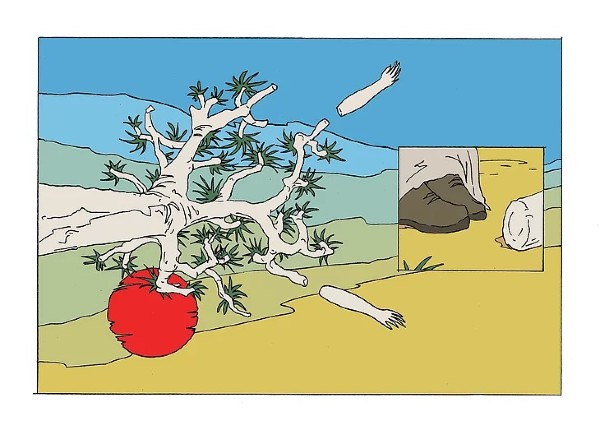
AO: One of your most recent comics is Quivertree (above) which is also available on your online store. How would you describe that short comic in terms of theme and style?
MEREIDA: The most deliberately abstract and ambiguous thing I’ve made, I think. It gestated during the languid days of lockdown 1.0 when I was dreaming vividly and longing for the outside world, so it follows more of a dream logic than maybe my other work. I drew on a wide range of influences such as the Peruvian desert, the work of artists Bill Viola and Heidi Bucher, and several species of plant I became thematically obsessed with. It’s intended to be open to interpretation, but broadly I was thinking about individual vs shared memory, and how we are influenced by the spaces and landscapes around us, which are two themes I’ve carried forward.
AO: Tell us about your creative process and the mediums you work in?
MEREIDA: I spend most of my time thinking and scribbling – my sketchbooks aren’t pretty, but they’re very useful. My mathematical brain loves thumbnailing and figuring out structures, problem-solving by juggling panels and page-turns and rhythm, and I spent a lot of this year madly cutting and folding paper at 2am. Once I’ve prepped and planned and finally get down to drawing, I tend to lose interest a bit, although I’ve been enjoying learning to colour digitally. All my linework is still hand-drawn, whether pen or ink or pencil, but colouring digitally is good for testing variations, changing the atmosphere. I see colouring a bit like adding a soundtrack as you can manipulate the mood of the art, employ motifs and make associations, tell the whole story through colour.
AO: You’ve been involved with the WIP Comics group, contributing to their anthologies and being a part of that comics network. How important has that been in terms of the support of your peers and what would be your advice to people just starting on their self-publishing journey in terms of getting their work out there and seen?
MEREIDA: I am beyond grateful to Joe [Stone] and everyone at WIP. I didn’t know anyone with an interest in comics beforehand so it has been a creative lifeline and great learning environment. I can’t overstate the value of sharing ideas and advice, giving and receiving criticism on work in progress, and it’s sadly something we haven’t been able to engage with much on my degree so far. Also, comics people you are all lovely!!!
It’s so good for building confidence to put your work out there – the anthologies especially give you something to work towards that you know will be let loose in the wild and it’s rewarding seeing your work alongside that of so many fantastic creators discovering their own voices. Making comics can feel lonely, but I come away from every session feeling fresh and part of a community. Long live comics support groups!
As for advice, I’m still young in the scene but I would suggest starting small and trying to get involved with other creators wherever you can. And I’m always in support of putting your work out there even if it’s not the most polished or fancily printed, you never know who you might meet or connect with through it.
AO: Obligatory pandemic question time. How has lockdown and the events of the last year affected your comics practice and how have you had to adapt?
MEREIDA: I’ve been incredibly lucky to start uni and therefore have external motivation and inspiration to create, although it means I’ve been a lil’ distracted form my personal comics practice. But sitting in the same room trying to draw every day isn’t very conducive to creativity, and drawing outside has been a lifeline. My sketchbook now lives in my bike basket.
AO: And finally what can we expect to see next from you? Is there any upcoming comics work you can tell us about?
MEREIDA: Yes! I have two upcoming projects about different facets of Filipino culture which are probably my most experimental so far in terms of form. As a biracial person I often find it hard to connect with my more distant side, so with these projects I am trying to engage with and learn about my Filipino heritage. One will be part of this year’s zine-based WIP Comics anthology and the other will be available at HCZF and Thought Bubble (and you can hopefully catch me in the flesh at the latter!).
Thank you for the thoughtful words and the support Andy!
For more on the work of Mereida Fajardo follow her on Twitter here and on Instagram here. You can visit her site here and her online store here.
Interview by Andy Oliver





